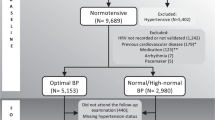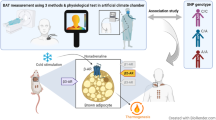Abstract
OBJECTIVE: To investigate the association of the promoter region −3826 A to G polymorphism of the uncoupling protein 1 (UCP1) gene with autonomic nervous system (ANS) activity and the interaction of the polymorphism with the Trp64Arg polymorphism of the β3 adrenergic receptor (β3AR).
SUBJECTS: Three-hundred and forty-nine young (mean age 20.4±2.1 y old), healthy Japanese males.
MEASUREMENTS: DNA was extracted from whole blood and genotyped by polymerase chain reaction restriction fragment length polymorphism. Plasma glucose, plasma insulin and body mass index (BMI) were measured. Frequency of family history of diabetes or obesity was determined by interview. Subjects randomly chosen from each genotype were examined for ANS activity during supine rest and standing by electrocardiogram power spectral analysis of heart rate variability.
RESULTS: UCP1 or β3AR polymorphism was not associated with BMI, plasma glucose, plasma insulin and frequency of family history of diabetes or obesity. The inhibitory effect of UCP1 polymorphism on ANS activity was observed only with occurrence of the variant of β3AR. The very low frequency component associated with thermoregulation in the sympathetic nervous system of homozygotes of UCP1 (GG) at supine rest was significantly lower than normal (AA, 203.2±50.3 vs 462.2±83.6 ms2; mean±s.e., P=0.021). A higher response to postural change to standing was also observed in both sympathetic and parasympathetic nervous activities of AA than of GG.
CONCLUSION: While UCP1 polymorphism alone does not affect ANS activity, it has a synergistic effect with β3AR polymorphism in decreasing sympathetic nervous system activity.
This is a preview of subscription content, access via your institution
Access options
Subscribe to this journal
Receive 12 print issues and online access
$259.00 per year
only $21.58 per issue
Buy this article
- Purchase on Springer Link
- Instant access to full article PDF
Prices may be subject to local taxes which are calculated during checkout



Similar content being viewed by others
References
Hoffman BB, Lefkowitz RJ . Catecholamines, sympathomimetric drugs, and adrenergic receptor antagonist Hardman In:, Limbird LE, Molinoff PM, Ruddon RW (eds). The pharmacological basis of therapeutics McGraw-Hill: New York 1996 pp 199–248.
Rothwell NJ, Stock MJ . A role for brown adipose tissue in diet induced thermogenesis Nature 1979 281: 31–35.
Trayhurn P, Mercer SW . Brown adipose tissue thermogenesis in obese animals Biochem Soc Trans 1986 14: 236–239.
Bray GA . Obesity, a disorder of nutrient partitioning: the MONALISA hypothesis J Nutr 1991 121: 1146–1162.
Walston J, Silver K, Bogardus C, Knowler WC, Celi FS, Austin S, Manning B, Strosberg AD, Stern MP, Raben N, Sorkin JD, Roth J, Shuldiner AR . Time of onset of non insulin dependent diabetes mellitus and genetic variation in the fl3-adrenergic receptor gene New Engl J Med 1995 333: 343–347.
Widen E, Lehto M, Kanninen T, Walston J, Shuldiner AR, Groop LC . Association of a polymorphism in the fl3-adrenergic receptor gene with features of the insulin resistance syndrome in Finns New Engl J Med 1995 333: 348–351.
Oppert JM, Vohl MC, Chagnon M, Dionne FT, Cassard-Doulcier AM, Ricquier D, Perusse L, Bouchard C . DNA polymorphism in the uncoupling protein (UCP) gene and human body fat Int J Obes Relat Metab Disord 1994 18: 526–531.
Clement K, Ruiz J, Cassard-Doulcier AM, Bouillaud F, Ricquier D, Basdevant A, Guy-Grand B, Froguel P . Additive effect of A→G (-3826) variant of the uncoupling protein gene and the Trp64Arg mutation of the beta 3-adrenergic receptor gene on weight gain in morbid obesity Int J Obes Relat Metab Disord 1996 20: 1062–1066.
Valve R, Heikkinen S, Rissanen A, Laakso M, Uusitupa M . Synergistic effect of polymorphisms in uncoupling protein 1 and beta3-adrenergic receptor genes on basal metabolic rate in obese Finns Diabetologia 1998 41: 357–361.
Lonnqvist F, Thome A, Nilsell K, Hoffstedt J, Arner P . A pathogenic role of visceral fat beta 3-adrenoceptors in obesity J Clin lnvest 1995 95: 1109–1116.
Klaus S, Casteilla L, Bouillaud F, Ricquier D . The uncoupling protein UCP: a membraneous mitochondrial ion carrier exclusively expressed in brown adipose tissue Int J Biochem 1991 23: 791–801.
Lowell BB, Flier JS . Brown adipose tissue, beta 3-adrenergic receptors, and obesity A Rev Med 1997 48: 307–316.
Shihara N, Yasuda K, Moritani T, Ue H, Adachi T, Tanaka H, Tsuda K, Seino Y . The association between Trp64Arg polymorphism of the beta3-adrenergic receptor and autonomic nervous system activity J Clin Endocrinol Metab 1999 84: 1623–1627.
Akselrod S, Gordon D, Ubel FA, Shannon DC, Berger AC, Cohen RJ . Power spectrum analysis of heart rate fluctuation: a quantitative probe of beat to beat cardiovascular control Science 1981 213: 220–222.
Akselrod S, Gordon D, Madwed JB, Snidman NC, Shannon DC, Cohen RJ . Hemodynamic regulation: investigation by spectral analysis Am J Physiol 1985 249: H867–H875.
Pomeranz B, Macaulay RJ, Caudill MA, Kutz I, Adam D, Gordon D, Kilborn KM, Barger AC, Shannon DC, Cohen RJ, Benson H . Assessment of autonomic function in humans by heart rate spectral analysis Am J Physiol 1985 248: H151–H153.
Pagani M, Lombardi F, Guzzetti S, Rimoldi O, Furlan R, Pizzinelli P, Sandrone G, Malfatto G, Dell'Orto S, Piccaluga E, Turiel M, Baselli G, Cerutti S, Malliani A . Power spectral analysis of heart rate and arterial pressure variabilities as a marker of sympatho-vagal interaction in man and conscious dog Circulation Res 1986 59: 178–193.
Kitney RI . Proceedings: Entrainment of the human RR interval by thermal stimuli J Physiol Lond 1975 252: 37P–38P.
Matsumoto T, Miyawaki T, Ue H, Kanda T, Zenji C, Moritani T . Autonomic responsiveness to acute cold exposure in obese and non-obese young women Int J Obes Relat Metab Disord 1999 23: 793–800.
Marks V, Lloyd K . Preservation of blood sample for glucose analysis by glucose oxidase Clin Chem Acta 1963 8: 326.
Tsuji K, Taminato T, Usami M, Ishida H, Kitano N, Fukumoto H, Koh G, Kurose T, Yamada Y, Yano H, Seino Y, Imura H . Characteristic features of insulin secretion in the streptozotocin induced NIDDM rat model Metabolism 1988 37: 1040–1044.
Ueda K, Tanizawa Y, Oota Y, Inoue H, Kizuki N, Inoue H, Tsukuda K, Asano T, Oka Y . Prevalence of the Trp64Arg missense variant of the fl3-adrenergic receptor gene in Japanese subjects Metabolism 1997 46: 199–202.
Moritani T, Hayashi T, Shinohara M, Mimasa F, Shibata M . Comparison of sympatho-vagal function among diabetic patients, normal controls and endurance athletes by heart rate spectral analysis J Sports Med Sci 1993 7: 31–39.
Moritani T, Hayashi T, Shinohara M, Mimasa F, Masuda I, Nakao K . Symapatho-vagal activities of NIDDM patients during exercise as determined by heart rate spectral analysis. In: Kawamori R, Vranic M, Horton ES, Kubota M (eds). Glucose fluxes, exercise and diabetes Smith-Gordon: London 1995 pp 91–96.
Oida E, Moritani T, Yamori Y . Tone-entropy analysis on cardiac recovery after dynamic exercise J Appl Physiol 1997 82: 1794–1801.
Rompeleman O, Coenen AJR, Kitney RI . Measurement of heart-rate variability: part 1—comparative study of heart-rate variability analysis methods Med Biol Engng Comput 1977 15: 233–239.
Saul JP, Albrecht P, Berger RD, Cohen RJ . Analysis of long term heart rate variability: methods, l/f scaling and implications Comp Cardiol 1988 14: 419–422.
Yamamoto Y, Hughson RL, Peterson JC . Autonomic control of heart rate during exercise studied by heart rate variability spectral analysis J Appl Physiol 1991 71: 1136–1142.
Kogure A, Yoshida T, Sakane N, Umekawa T, Takakura Y, Kondo M . Synergic effect of polymorphisms in uncoupling protein 1 and beta3-adrenergic receptor genes on weight loss in obese Japanese Diabetologia 1998 41: 1399.
Hayakawa T, Nagai Y, Taniguchi M, Yamashita H, Takamura T, Abe T, Nomura G, Kobayashi K . Phenotypic characterization of the beta3-adrenergic receptor mutation and the uncoupling protein 1 polymorphism in Japanese men Metabolism 1999 48: 636–640.
Pihlajamaki J, Rissanen J, Valve R, Heikkinen S, Karjalainen L, Laakso M . Different regulation of free fatty acid levels and glucose oxidation by the Trp64Arg polymorphism of the beta3-adrenergic receptor gene and the promoter variant (A−3826G) of the uncoupling protein 1 gene in familial combined hyperlipidemia Metabolism 1998 47: 1397–1402.
Fogelholm M, Valve R, Kukkonen-Harjula K, Nenonen A, Hakkarainen V, Laakso M, Uusitupa M . Additive effects of the mutations in the beta3-adrenergic receptor and uncoupling protein-1 genes on weight loss and weight maintenance in Finnish women J Clin Endocrinol Metab 1998 83: 4246–4250.
Urhammer SA, Fridberg M, Sorensen TI, Echwald SM, Andersen T, Tybjaerg-Hansen A, Clausen JO, Pedersen O . Studies of genetic variability of the uncoupling protein 1 gene in Caucasian subjects with juvenile-onset obesity J Clin Endocrinol Metab 1997 82: 4069–4074.
Ravussin E, Lillioja S, Knowler WC, Christin L, Freymond D, Abbott WG, Boyce V, Howard BV, Bogardus C . Reduced rate of energy expenditure as a risk factor for body weight gain New Engl J Med 1988 318: 467–472.
Esterbauer H, Oberkofler H, Liu YM, Breban D, Hell E, Krempler F, Patsch W . Uncoupling protein-1 mRNA expression in obese human subjects: the role of sequence variations at the uncouplingprotein-1 gene locus J Lipid Res 1998 39: 834–844.
Rehnmark S, Nechad M, Herron D, Cannon B, Nedergaard J . Alpha- and beta-adrenergic induction of the expression of the uncoupling protein thermogenin in brown adipocytes differentiated in culture J Biol Chem 1990 265: 16464–16471.
Yo Y, Nagano M, Nagano N, Iiyama K, Higaki J, Mikami H, Ogihara T . Effects of age and hypertension on autonomic nervous regulation during passive head up tilt Hypertension 1994 23: I82–I86.
Acknowledgements
This study was supported by grants-in-aids for scientific research from the Ministry of Education, Science, Sports and Culture (11839012, 10770569), health sciences research grants (Research on Human Genome and Gene Therapy, Choju Kagaku Sougou) from the Ministry of Health and Welfare, Japan, a grant from the Smoking Research Foundation and a grant for the ‘Research for the Future’ Program from the Japan Society for the Promotion of Science (JSPS RFTF97I00201). We thank Ms Kyoko Hishida and Mr Morisumi Ogido for technical assistance.
Author information
Authors and Affiliations
Rights and permissions
About this article
Cite this article
Shihara, N., Yasuda, K., Moritani, T. et al. Synergistic effect of polymorphisms of uncoupling protein 1 and β3-adrenergic receptor genes on autonomic nervous system activity. Int J Obes 25, 761–766 (2001). https://doi.org/10.1038/sj.ijo.0801629
Received:
Revised:
Accepted:
Published:
Issue Date:
DOI: https://doi.org/10.1038/sj.ijo.0801629
Keywords
This article is cited by
-
Impact of UCP1 and β3AR gene polymorphisms on age-related changes in brown adipose tissue and adiposity in humans
International Journal of Obesity (2013)
-
The polymorphisms of UCP1 genes associated with fat metabolism, obesity and diabetes
Molecular Biology Reports (2010)
-
The ADRB3 Trp64Arg variant and BMI: a meta-analysis of 44 833 individuals
International Journal of Obesity (2008)
-
A Deletion in the α2B‐Adrenergic Receptor Gene and Autonomic Nervous Function in Central Obesity
Obesity Research (2003)
-
The Human Obesity Gene Map: The 2001 Update
Obesity Research (2002)



